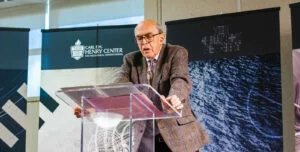This is a fascinating and helpful book, important in our day. I am thankful for it. It is not a perfect book, of course. There is only one of those! I cannot agree with everything Joshua Swamidass writes. In fact, that would not be possible because he allows for so many mutually contradictory options for reading various parts of the Genesis story and other passages in the Bible. His goal is not to be definitive but suggestive, leading to a “peaceful” engagement between the Bible and evolutionary science on various matters, especially the historical Adam and Eve.
The Bible and Science
As for myself, the main way this book and the discussion it has generated is helpful is in its “push back” against the common overreach of evolutionary science against the possibility of an historical Adam and Eve at the headwaters of humanity. His genealogical versus genetic approach to human descent opens a door of fresh air into a discussion that some believing and unbelieving evolutionary scientists have tried to smother. This shift makes good biblical sense. Genesis 1–11 develops genealogical descent, not genetics, and this runs through the entire Bible. 1 Chronicles 1–9 contains an extensive genealogy that runs all the way from Adam to post-exilic Israel. The New Testament begins with a genealogy that runs from Abraham (Genesis 12) to Jesus, and Luke 3:23–37 has one that extends from Jesus all the way back to Adam, “the son of God.”
Nothing I write in this short essay intends to express rejection or reaction against science or scientists. I am sincerely thankful for them and for the many great benefits of their work. Their work, however, calls for careful evaluation and critique from within the scientific world. It also requires that those of us who are not scientists understand the limits of what scientists can legitimately conclude from their work.
The same is true for the work of biblical and theological scholars. On the one hand, the history of these disciplines shows clearly that there are important passages and concepts in the Bible that are open for significant discussion. On the other hand, I recall here Meir Sternberg’s important dictum about the Bible as a “foolproof composition.” As he puts it, the Bible “is difficult to read, easy to underread and overread and even misread, but virtually impossible to, so to speak, counterread,” unless one intentionally reads it in “bad faith,” as some are determined to do in the academy or other places where the agenda is brought to the text rather than gained from it. “The essentials are made transparent to all comers: the story line, the world order, the value system.”Meir Sternberg, The Poetics of Biblical Narrative: Ideological Literature and the Drama of Reading (Bloomington, IN: Indiana University Press, 1985), 50–51. In other words, the Bible is essentially clear in what it says and means; that is, if one is willing to let it speak and mean what it says.
Reading the Bible Well
In my view, this is one way in which Joshua’s approach is vulnerable to criticism. On the one hand, he has a very fertile mind with a creative imagination. He can imagine, therefore, all sorts of options for how we might read various passages in the Bible and make theological arguments from them. I mean this as a compliment, but also as a caution. He believes in the reliability of the Bible, as I do, but his approach lends itself to a kind of “smorgasbord” style to the reading of it. Swamidass does not mean it this way (see more on this below), but the sheer number of possible readings on all sorts of matters, some of them not suggested by the text in any way, leaves this impression. This is all fine and good for his concern to create room for peace between the Bible and evolutionary science. However, this leaves one with the distinct impression that, as far as Swamidass is concerned, it does not matter which option one takes in any particular case. I do not mean to suggest that Joshua has no limits in this regard. He does, and sets such limits often, but I believe it is much better to come at the reading of the Bible in a very different way.
In the study of the Bible, we need to do what is sometimes referred to as “close reading” of the biblical text. The goal is to allow the particular passage to drive the reader detail by detail to its meaning in its context. No one does this perfectly, since we are all under the inescapable influence of our own experience and outside forces in our minds and lives. Nevertheless, the goal remains intact. This means that the reader works to gear his or her thinking to the particular passage in its textual and world context. Of course, the larger context of any passage includes the larger biblical canon as a whole, but each passage within it must have its say. Other passages do not override the meaning of the one currently under consideration. This is the only way I know to maintain a reading of the Bible in which the Bible is in control rather than previous exegetical and theological commitments of the one reading it.
Humanity in the Image and Likeness of God
I would apply this way of reading and understanding the Bible even to the major theological debates that continued over the centuries in the church. One that stands out to me is the question of what it means to be human and how that relates to the biblical concept of the imago Dei (see esp. pp. 105–16 and 179–81; cf. Gen 1:26–28; 5:1–3; 9:6; and also Rom 8:29; Col 3:10; etc.). Swamidass gives the three common options among biblical and theological scholars for understanding what it means when God says he created us in his image and according to his likeness (Gen 1:26): the structuralist, vocational, and relational approaches, as he refers to them.
The fact of the matter is that the text clearly focuses on our vocation or function within the rest of creation. According to Genesis 1:26, God said, “Let us make humanity in our image, as our likeness, that they may rule over the fish of the sea, and the birds of the heavens, and the livestock, and all the (wild animals) of the earth, and all the creeping things that creep upon the ground.”The fact of the matter is that the text clearly focuses on our vocation or function within the rest of creation. The plural verb “that they may rule” indicates that “humanity” as a whole is intended here, not just one man. The grammatical syntax of the same Hebrew clause also indicates that this is a purpose clause, “that they may rule.” Verse 28 reiterates this same purpose for God making us male and female in v. 27. We need to multiply and occupy the earth so that we can fulfill our function of ruling over (i.e., managing) all the animals.
There is no mention here of the metaphysical “capacities” on which the structuralist view focuses its attention. Some object that being in the image of God is not the same as functioning so (i.e., an ontological objection). This changes nothing. The core problem is that the structuralist view ignores the basic Hebrew lexicography. The expression “in our image” uses a common word in the OT for a physical statue. Combined with “as our likeness,” the expression as a whole means that we are like a physical statue of God, standing here in his physical world to represent him physically in accordance with his nature and design. No, we are not just a dead stone or carved wood made into a statue. It is figurative. We are a living “statue” of God in the world, individually and corporately.For further biblical and ANE support see Richard E. Averbeck, “A Literary Day, Inter-Textual, and Contextual Reading of Genesis 1 and 2,” in Reading Genesis 1-2: An Evangelical Conversation, ed. Daryl Charles (Peabody, MA: Hendrickson, 2013), 24–26.
The sooner we discard the structuralist approach the better off we will be in terms of reading the text well. We need to keep the focus where the text puts it. This does not deny the fact that God gave us the capacities to function the way he intended, but God’s concern here is how we live in the world. This includes our existence as relational beings—relationship with God and one another. All the passages cited above, Old Testament and New, keep the focus on how we live in the world. Colossians 3:10, for example, talks about us being renewed to the knowledge of the image of our Creator in the context of putting off the old self and putting on the new. It is about how we live and function in the world. It is about our character.
Swamidass is not against this kind of reading of the Bible. It is just not what he is trying to do in this book. Instead, he is trying to open up options for different readers to read it according to what they see in the text, including its relationship to the supposedly assured results of evolutionary science. He is inviting people to a more irenic discussion of what the text is actually intending to say, and how that relates to the evolutionary science he affirms throughout his book. Joshua consistently argues that evolution may have fractured the story of Adam and Eve, but as he puts it in one place, “we can recover it now. From a scientific point of view, all that is required is people outside the Garden, with whom Adam and Eve’s offspring eventually interbreed” (p. 173).
Pre-Adamic Hominids
For his proposal to work, these people outside the Garden before Adam and Eve are non-negotiable. For there to be peace between the Bible and the evolutionary science to which he is committed, they must have been there. He makes note of some supposed biblical “hints” of the existence of these people outside the garden, and argues for their suggestive valueFor his proposal to work, these people outside the Garden before Adam and Eve are non-negotiable. For there to be peace between the Bible and the evolutionary science to which he is committed, they must have been there. (see the full discussion on pp. 111–50 and esp. the biblical passages on pp. 135–36 and 140–50). Some biblical scholars see them as valid. Others do not. Still others are undecided. The discussion is a quagmire of speculation and debate. There is a lot to be unsure about here.See the full historical review of this proposal and the debate surrounding it in David N. Livingstone, Adam’s Ancestors: Race, Religion & Politics of Human Origins (Baltimore, MD: The Johns Hopkins University Press, 2008).
Who was Cain afraid would kill him (Gen 4:14), and where did he get his wife (v. 17)? The traditional Rabbinic and Christian answer derives from Genesis 5:4, “Adam . . . had other sons and daughters” (cf. vv. 7, 10, and following; the pattern suggests Adam also had other sons and daughters before Seth, not just Cain and Abel). The text does not tell us how old Cain was when he killed Abel. The population could well have expanded quite extensively by that time, so Cain could have feared the potential vengeance of the rest of the population, especially in light of the standard cultural pattern of family vengeance (see even later in Israel, Num 35:9-15). He would have obtained his wife from among them as well (sibling marriage was not a problem in this early time, but later it was prohibited, Lev 18).U. Cassuto, A Commentary on the Book of Genesis: Part I, From Adam to Noah, Genesis I-VI 8, transl. by Israel Abrahams (Jerusalem: The Magnes Press, The Hebrew University, 1961), 229. God’s marking Cain with a sign would suggest the same thing, along with his curse, “anyone who kills Cain will suffer vengeance seven times over” (Gen 4:15). Swamidass suggests that the best answer is to posit Pre-Adamites for Cain’s fear and his wife.
Perhaps the strongest biblical argument for Pre-Adamic people is the reference to the Nephilim in Genesis 6:4, “The Nephilim were on the earth in those days—and also afterward—when the sons of God went to the daughters of humans and had children by them. They were the heroes of old, men of renown” (NIV). The relationship between v. 4 and the previous account of the sons of God and daughters of humans (vv. 1–3) is a subject of debate among scholars. The whole passage has fascinated and confused readers and writers since ancient days. Some traditions and scholars take the Nephilim to be the offspring of this union. 1 Enoch 6–12 develops a full-fledged demonology from the Genesis 6 story, and includes the birth of four hundred foot tall giants from the union.James H. Charlesworth, ed., The Old Testament Pseudepigrapha, 2 vols. (Garden City, NY: Doubleday, 1983-85), 1.6–12. See also Sirach 16:7 in the Apocrypha and the Qumran sectarian scrolls Damascus Document 2:14–3:13 and 4Q Ages of Creation. This is purely legendary, of course. 2 Peter 2:4–6 and Jude 6–7 support the understanding that the Gen 6:1–2 incident involves angels somehow taking up union with human women, but they do not connect this to the Nephilim in any way.
Other scholars take the Nephilim to be a separate population, not the offspring of the union in Genesis 6:1–2. They constituted another factor in the pre-flood world that promoted extreme violence, which, in turn, motivated God to bring the flood upon the earth (Gen 6:5–17).See, e.g., the full and careful discussion in Kenneth A. Mathews, Genesis 1-11:26, NAC 1A (Nashville, TN: Broadman & Holman, 1996), 335–39, and Victor P. Hamilton, The Book of Genesis 1-17, NICOT (Grand Rapids, MI: Eerdmans Publishing Co., 1990), 269–71. In my view, the Hebrew grammar of v. 4 supports this reading. It suggests that the Nephilim were already there when the incident of vv. 1–2 took place: “The Nephilim were on the earth in those days—and also afterward—when . . .” (v. 4a). If this is correct, the question for us here is who were they? Were they descendants of Pre-Adamites?
Numbers 13:33 includes a reference to them in the negative report of the spies that spied out the land: “We saw the Nephilim there (the descendants of Anak come from the Nephilim). We seemed like grasshoppers in our own eyes, and we looked the same to them” (NIV). Who were these later “Nephilim” that the spies saw in the Promised Land? According to the biblical storyline, however, the flood eliminated all the Nephilim referred to in Genesis 6:4. Some have concluded, therefore, “. . . the label is not ethnic,” suggesting, “. . . they are heroic figures perhaps of the sort exemplified by Gilgamesh.” The Gilgamesh epic describes him as an ancient king of Uruk,This makes me cautious about seeing the Nephilim as descendants of Pre-Adamites. Some good evangelical scholars, however, have allowed for this possibility of Pre-Adamic hominids. whom some texts say was fifteen feet tall and having a stride of nine feet.See, e.g., John H. Walton, “Genesis,” in Zondervan Illustrated Bible Backgrounds Commentary, Volume 1, ed. John H. Walton (Grand Rapids, MI: Zondervan 2009), 45. In both passages, the LXX translates the term as hoi gigantes “the giants.” Numbers 13:33 adds, “the descendants of Anak come from the Nephilim” (lit. ‘the sons of Anak are from the Nephilim’; cf. Num 13:22, 28; Deut1:28; 2:10, 11, 21; 9:1–3 they were “strong and tall”; Josh 11:21–22; 14:12, 15; 15:14; 21:11; Judg 1:20).
Ezekiel 32:17–27 may support this interpretation. The passage is describing the fate of fallen Egyptian warriors. The term Nephilim (Hebrew nefilîm) most likely derives from the common Hebrew verb nāfal “to fall” and means “fallen ones.” This verb appears numerous times in Ezekiel 32:20–27 (vv. 20, 22, 23, 24, 27), referring to fallen warriors. According to v. 27, “But they do not lie with the fallen warriors of old, who went down to the realm of the dead with their weapons of war—their swords placed under their heads and their shields resting on their bones . . .” (NIV). The word “fallen” is Hebrew nōfelîm, using the same consonants as Nephilim (nefilîm), but with different vowels. As is well known, the Hebrew Bible originally wrote only consonants, except in places where a few consonants could sometimes indicate certain vowels. One can imagine how easy it would be to identify the one with the other, especially since both Genesis 6:4 and Ezekiel 32:27 also use the same word for “warriors, heroes.”See the related remarks in Cassuto, Commentary on Genesis I-VI 8, 298-301 and Westermann, Genesis 1-11, 378.
This makes me cautious about seeing the Nephilim as descendants of Pre-Adamites. Some good evangelical scholars, however, have allowed for this possibility of Pre-Adamic hominids, whether they would associate them with the Nephilim or not.See C. John Collins, Did Adam and Eve Really Exist? Who they Were and Why You Should Care (Wheaton, IL: Crossway, 2011), 116–31 for a clear summary and evaluation of the discussion among evangelicals. Collins is cautious, and careful to maintain a clear commitment to biblical priorities along the way. I am willing to reconsider it in the future, but, as of now, it seems to me the term Nephilim refers to exceptionally big and strong warrior peoples that became famous in the ancient days. They arose from time to time, like Goliath in 1 Samuel 7:4–17. I am also willing to patiently wait and see if other options arise from the science that keeps changing, although my evolutionary creationist friends tell me that this part of the science will not change. Biblical scholars who are early adopters of a scientific consensus can find themselves “hanging in thin air,” so to speak, as Swamidass’s book clearly shows.
Conclusion
In the meantime, his discussion has helped me to take more careful note of the fact that Genesis 1 presents humans as “pastoralists,” so to speak, occupied with animals. The account of the creation of Adam and Eve in Genesis 2, on the other hand, pictures them as agriculturalists, cultivating the ground and caring for the orchard in the Garden of Eden (Gen 2:15–17; cf. also v. 5b). According to Genesis 1:11–13, God designed the earth itself to bring forth plant life with no help from people, and the plants come back into view at the end of the chapter as the nurturing environment from which man and animal readily get their food (vv. 29–30). I wonder if this might suggest that we should see the creation of humanity in Genesis 1 more broadly, and Genesis 2 as a sequential account of the later special creation of the model man and woman, Adam and Eve, something similar to what Joshua Swamidass suggests (pp. 173–83). On the other hand, could it be that all we should see here is the distinction between Genesis 1 as forming and filling the cosmos as a whole, and Genesis 2 as a further explanation of the development of human life on the earth?
As for myself, I suspect that the whole discussion will keep coming back around again, and then again, as scientists do better science leading in good conscience to better conclusions and implications. Similarly, as scholars and readers of the Bible we need to remain open to reading the Bible better too, with an open mind, not ignoring useful information that might further our understanding of its immense and eternal treasures. We need humility on both the scientific as well as on the biblical, theological, and philosophical sides of this discussion.








Comments
Be the first one to make a comment!